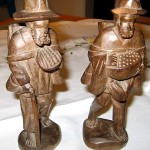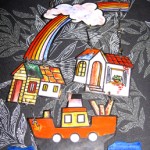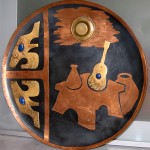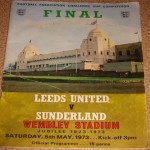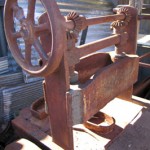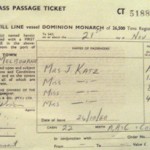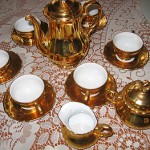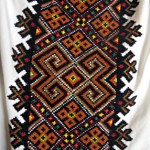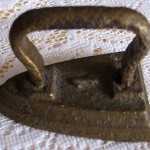(nee Fernandez)
Chilean
Santiago, Chile
Santiago, Chile on 23 March 1973
Sydney on 26 March 1973
Relatives’ home in Hill Street, Cabramatta (SW Sydney).
Viscount Caravans, Liverpool (SW Sydney) where I worked padding bedheads.
Sharp Corporation, Yennora welding wiring into television sets; Beaufort at Lansvale where I made boat lifejackets (both in SW Sydney); Grace Bros at Lidcombe (W Sydney) where I worked as a storeman and packer.
I was born Olga Fernandez on 18 October 1942 in Santiago, Chile. My married surname is Sereno.
My father was a military man and I don’t know much about him as he died when I was very young. My mother also died when I was about three or four so I was orphaned and had no siblings. I grew up under the care of an aunt who was absolutely everything for me. She never married and really dedicated her life to me. I called her ‘Mother’.
My aunt said that she did not marry because she was afraid that any proposed husband may reject me. She worked to support us by dressmaking and hairdressing. She came with us to Australia and was still here when she died about 20 years ago.
I my Catholic school considered school terrible. I did not enjoy it at all. When I left I went to assist an uncle who was an optometrist and I did a secretarial course. I did not [do] secretarial work though as I met Oswald, who was an accountant.
Oswald lived a long way from Santiago and he would travel to see me every weekend for about a year and a half. Finally we married in Santiago and I went to live at his house in Vina del Mar. We lived with his mother for about three months and whilst waiting for our own apartment, I had a serious accident.
I was waiting to cross a street and was hit by a car. It was very serious, made more so by the fact my pelvis had been fractured in three places and that I was also expecting our first child. My baby was born by Caesarean section as was my other child.
Chile was in a very bad position politically and food and clothing were difficult to buy. We had to queue to obtain food and we knew that there would be no quality of life in Chile for us. We came to Australia as tourists on a six month visa so that we could have a good look at it in anticipation of perhaps migrating.
We flew from Santiago on 23 March 1973 by Lan Chile. My son was seven and my daughter was four. I felt most sad when we left as I had really not wanted to migrate, but my husband did not like what was happening in Chile and so it was to be.
I brought my very loved doll with me from Chile as it is very special to me. It was bought in Santiago by a close relative and is the Chilean equivalent of the Barbie doll, I suppose! It is called a huasa doll. It is dressed in the typical Chilean costume which would be worn on special occasions and festive days such as our Independence Day on 18 September.
I also brought a number of objects from Chile as a fond reminder of my homeland, including a façade of a typical Chilean house. It is beautifully made from wood but the original Chilean homes of course were usually made of adobe or straw and mud. It was a present on our departure from a cousin and is very much treasured.
My teapot was also a gift from Chile and is made of clay, as is the bowl which can be used as a sugar bowl or saucer. As well, I have this lovely replica of a pot-bellied stove, all of which came with us from Chile and is reminiscent of the type of stove that Chilean people used. They are all handmade of clay.
I have two stone churches we brought with us which are used as decoration. They were made in Chile. One of the stones used in their manufacture is called lapis lazuli, which is the national stone of Chile. The two small figures made of wood represent farm workmen who wander from place to place doing odd jobs just for their keep. We call them arrieros.
My copper pieces are a bracero which stands on a stove and contains water or teas, and the iron which was heated on the stove and which was used to iron clothes. They bring back fond memories of my grandparents as they used to be part of their household.
The small boxes are made of copper and decorated with enamel. They also were made in Chile and were specially loved by my husband as an expression of Chilean art. There are other copper decorations and they are special to us as Chile is very rich in copper. The copper plate is especially loved by me. I am especially proud of my objects as they are a connection between my life here and my previous one in Chile.
We arrived at Sydney Airport from Chile on 26 March 1973. Our arrival was complicated in one way in that we arrived on the day that daylight saving had ended and my husband’s cousin, who was to meet us at the airport, became confused and did not leave for the airport at the new correct time. I took his non-arrival as a sign that he did not want us and so did not want to go to their home, but we made our own way there. When we arrived we found that the cousin was about to leave for the airport to collect us.
We stayed at their house in Cabramatta [in south-west Sydney] for about two months and then we found a flat to rent. It was only two bedrooms, which was not exactly what we wanted as we were three adults and two children. It was in High Street, Cabramatta and was very crowded but we only stayed there for about three months and then found a two bedroom flat in Church Street, Cabramatta, where we remained for six months.
We liked what we saw [in Australia] and although we were just tourists we straight away began the necessary paperwork with the hope that we could stay. We were afraid that at the end of six months we would have to return to Chile. We had sold everything and so had no home there. It was to be two years before all was in order and we were legally allowed to stay.
As we had arrived as tourists we were not offered the chance of learning English as other migrants were, but my husband started to learn it in his spare time. [He] found employment as a carpenter at Viscount Caravans in Orange Grove Road, Liverpool. This was a job that he had never before worked at and when he began he did not even know how to hold a hammer! They had to teach him that. We then moved house to a three bedroom flat in Hughes Street, Cabramatta and later we bought a villa in Long Street, Cabramatta.
I was still really wanting to go home but felt that I should find work to keep me busy and I also went to Viscount Caravans to work. We had a great need of money as there were five of us for my husband to support and that did not seem fair to me.
At Viscount I learnt how to upholster the bedheads in the caravans and also the lounge room bed. My job was to put sponge onto the frame and then cover it with fabric which I attached with an air gun. The bedhead then had buttons applied like padded squares. This was my first job ever and I liked it.
I remained at Viscount for a year but was then put off as the work was seasonal and they were retrenching. My husband made me accept retrenchment as my fingers were in a bad state from the work of pulling the string tightly when attaching the buttons. I had a lot of pain and waited for it to heal before I looked for another job.
My next position was at Sharp Corporation at Yennora where I did assembling using a welder. I had to weld small cables into television sets and I was there for two years. In the meantime my husband had moved from the factory to the office at Viscount.
After I finished at Sharp I went to Beaufort at Lansvale, which was a factory which manufactured boat lifesaving jackets. My job was to glue the jackets together and I remained there for ten years.
After that I was at Grace Bros at Lidcombe [in western Sydney] where I worked as a storeman and packer. After 14 years there I retired in April 1998 as I could no longer work full-time [because] of carpal tunnel problems.
My main occupation after retirement is being involved with my four grandchildren. My husband retired only last year and had spent his latter years in Australia working as an accountant.
We have been back to Chile five or six times but, although I did not originally want to leave Chile, I would never think of leaving Australia.





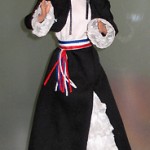
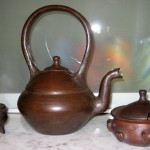
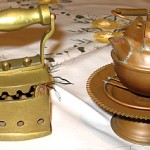
!["These boxes are made of copper and enamel. Chile is renowned for its copper and its [manufacturing] techniques and these boxes were especially loved by my husband as an expression of Chilean art."](../../../cms/wp-content/uploads/2010/01/sereno-boxes-150x150.jpg)
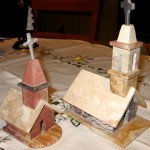
!["[This] is made of wood and constructed to replicate Chilean houses of the day. It was a present from a cousin on our departure to Australia."](../../../cms/wp-content/uploads/2010/01/sereno-house-150x150.jpg)
